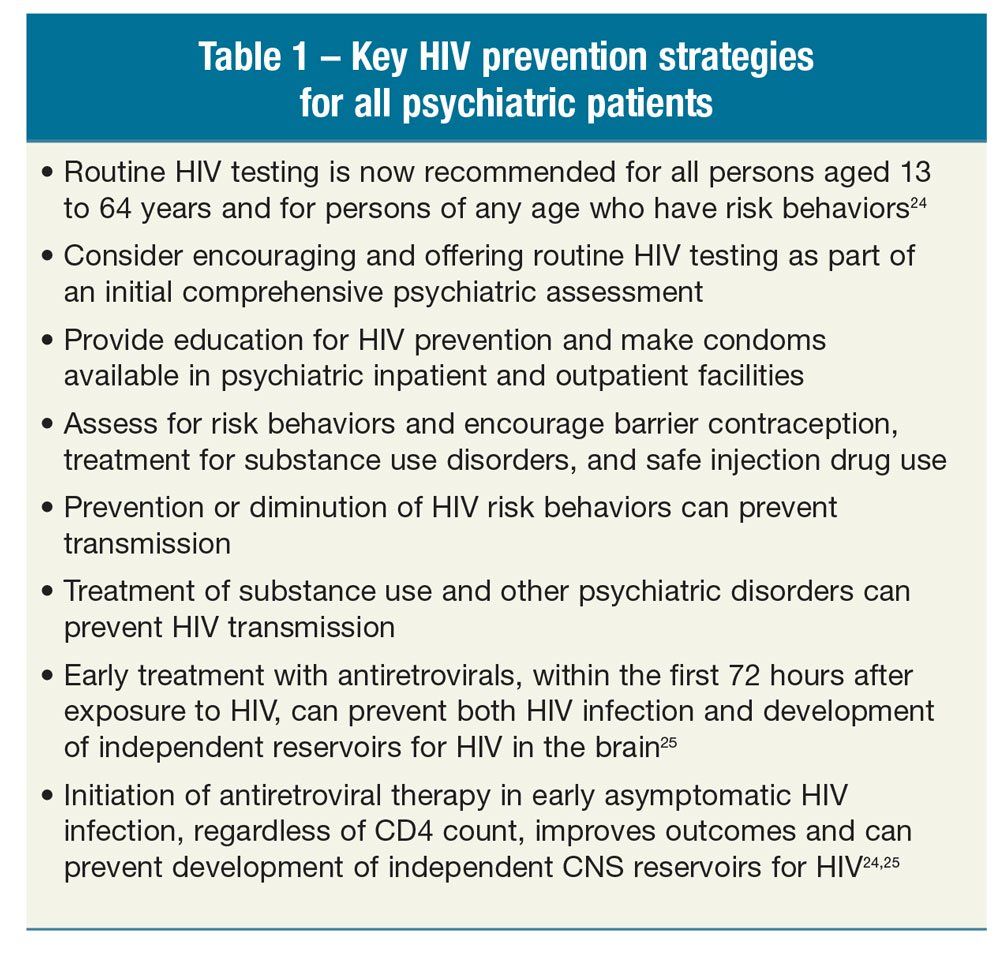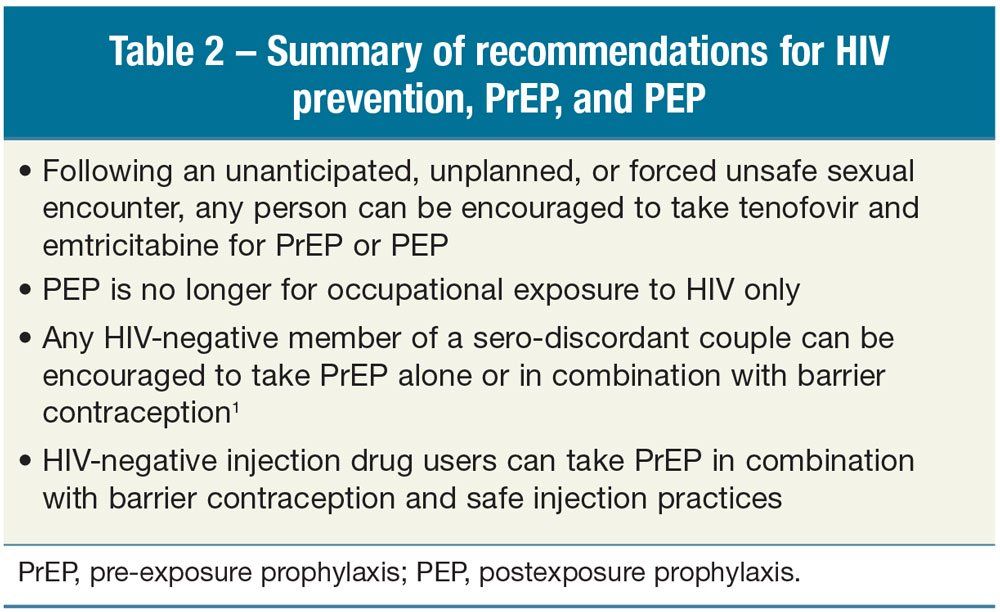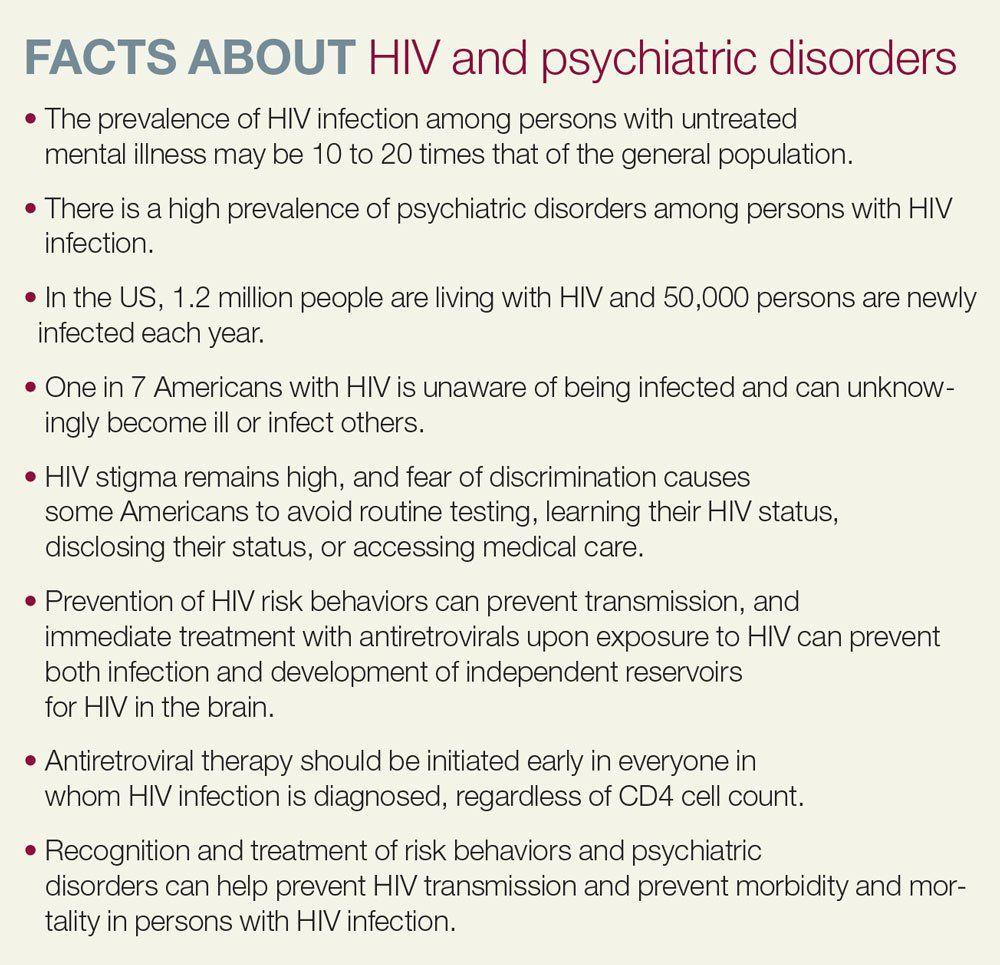The Role of Psychiatrists in HIV Prevention
Because over half of persons with HIV infection have a lifetime history of depression or bipolar disorder, psychiatrists are uniquely positioned to provide both preventive and therapeutic interventions to vulnerable patients.
Table 1 – Key HIV prevention strategies for all psychiatric patients

Table 2 – Summary of recommendations for HIV prevention, PrEP, and PEP

Table 3 – Key points related to psychiatric disorders in persons with HIV infection

FACTS ABOUT HIV and psychiatric disorders

Table 4 – Examples of recommended psycho-pharmacologic agents

HIV/AIDS Psychiatry

FROM THE ACADEMY OF PSYCHOSOMATIC MEDICINE
Psychiatrists are uniquely positioned to provide both preventive and therapeutic interventions for children, adolescents, adults, and elderly persons who are vulnerable to, infected with, or affected by HIV. Psychiatrists routinely take patient histories that include substance use; sexual activities; relationships; and trauma, including childhood neglect and emotional, physical, and sexual abuse-as well as comprehensive medical, psychiatric, and social histories. Progress in preventing HIV infection has lagged far behind progress in the disease’s diagnosis and treatment. Stigma, discrimination, and fear may prevent persons with risk behaviors such as unprotected sex and injection drug use from getting tested, learning that they have HIV infection, or obtaining much needed care.
While there are similarities, HIV/AIDS differs from many complex and severe medical illnesses because it is an infectious and stigmatized disease that can lead to and is associated with other multimorbid medical illnesses. It is also associated with psychiatric illnesses because of the affinity of HIV for brain and neural tissue as well as its profound impact on persons who are infected.
Increasing awareness of stigma, discrimination, and psychiatric factors associated with the HIV pandemic can lead to decreased transmission as well as early diagnosis and treatment. Compassionate medical and psychiatric care can mitigate suffering in persons at risk for, infected with, and affected by HIV.
Prevention of HIV infection
Strategies have been developed for communicating, preventing HIV transmission, improving adherence to risk reduction and medical care, addressing health care disparities, and ameliorating stigma. These include the National AIDS Strategy Updated to 2020, the 2015 Blueprint to Eliminate AIDS in New York State, and the World Health Association Guidelines. Key prevention strategies for all patients are presented in Table 1.
Treatment as prevention
Persons who are thought to be the most substantially vulnerable to HIV infection include HIV-negative members of serodiscordant couples and HIV-negative injection drug users. An HIV-negative member of a serodiscordant couple may take pre-exposure prophylaxis (PrEP) to prevent infection. PrEP and postexposure prophylaxis (PEP) with antiretroviral medications such as tenofovir together with emtricitabine-in combination with safe sex, barrier contraception, and safe injection drug practices-can prevent HIV transmission in serodiscordant couples. The evidence for the use of PrEP and PEP in serodiscordant couples is strong.1
Psychiatrists can prevent transmission of HIV, ameliorate HIV stigma and suffering, decrease morbidity and mortality, and provide care for persons infected and affected by HIV.
PrEP may also be an effective measure in persons with HIV infection who are injection drug users. In 2014 and 2015, both the Centers for Disease Control and the World Health Organization included injection drug users in their endorsement of PrEP as an HIV prevention method. Much of the evidence for the efficacy of PrEP in injection drug users was derived from the Bangkok Tenofovir Study, which showed a 48.9% reduction in HIV infections.2 Ongoing PrEP demonstration projects have included injection drug users in their participant pool, but data concerning overall awareness, uptake, and engagement in injection drug users are limited. A summary of recommendations for prevention and pre- and postexposure prophylaxis is provided in Table 2.
Psychiatric disorders and HIV infection
The comprehensive, compassionate, and nonjudgmental approach to the care of persons at risk for or infected with HIV begins with a thorough psychiatric evaluation. This evaluation is designed to provide an ego-supportive assessment.3 Shaking hands, while important with all initial patient encounters, takes on special relevance in the context of AIDSism, or HIV stigma and discrimination against gay persons, drug users, and those with infectious disease.4 Assessing the impact of HIV infection is best done by asking about the individual’s understanding of his or her illness. Special attention is needed to address sensitive issues related to sexual history, gender, and sexuality. See Table 3 for key issues related to neurocognitive disorders, delirium, and substance abuse in persons with HIV infection.
Depression and HIV infection. It can be challenging to determine the prevalence of depressive disorders in persons with HIV infection because of the overlap of the physiological changes associated with HIV illness and the somatic symptoms of depression, such as appetite changes, anergia, fatigue, loss of libido, sleep disturbances, and cognitive impairment. Overwhelming evidence indicates that depressive manifestations and disorders are highly prevalent in persons with HIV infection.5,6
Data show that persons with HIV infection and comorbid depression have a lower quality of life and are less likely to be adherent to antiretroviral therapy. Moreover, inadequate self-care, significant impairment in overall functioning, and consequent social isolation lead to poorer treatment outcomes.6 Approximately 53% of persons with HIV infection have a lifetime history of major depressive disorder or bipolar disorder.7 In a study by Vance and colleagues,8 persons with HIV infection aged 50 and older consistently reported higher levels of depression than same-age uninfected peers.
These data provide strong evidence for the importance of early screening for depression and aggressive treatment in persons with HIV infection. Screening tools for depression in persons with HIV infection include the Beck Depression Inventory, the Center for Epidemiologic Studies Depression Scale Revised, the Patient Health Questionnaire-9, and the Hospital Anxiety and Depression Scale.9-11 However, screening instruments for depression are not sufficient to diagnose depressive disorders; therefore, all persons with positive screening results for depression should be comprehensively evaluated for depressive disorders and other co-occurring psychiatric disorders.
The effective management of depression in persons with HIV infection includes antidepressants (SSRIs and SNRIs) and psychosocial treatments (cognitive behavioral therapy, interpersonal therapy, stress management, and psychoeducation), or a combination of both.12,13
PTSD and HIV infection. PTSD is highly prevalent in persons with HIV infection and increases morbidity risk.14-17 It is often overlooked in persons with HIV/AIDS because it may be overshadowed by other psychiatric diagnoses.17 The effect is bidirectional. For example, intimate partner violence or a history of childhood trauma or childhood sexual trauma are all risk factors for HIV infection as well as for PTSD. The severity of HIV-related PTSD symptoms is associated with a greater number of HIV-related physical symptoms, extensive history of pre-HIV trauma, decreased social support, increased perception of stigma, and negative life events. Moreover, PTSD is often multimorbid with other psychiatric and medical disorders, pain, and depressive symptoms.
Compassionate medical and psychiatric care can mitigate suffering in persons at risk for, infected with, and affected by HIV.
PTSD is associated with nonadherence to risk reduction and medical care. The diagnosis of PTSD is further complicated by repression or retrograde amnesia for traumatic events and difficulties in forming trusting relationships and disclosing trauma (if it is recalled).
The syndemics of psychiatric disorders, violence, and HIV infection
In persons with HIV infection, there is a high incidence of early childhood and other trauma with consequent PTSD, substance use disorders, and other psychiatric disorders. Violence may include perpetuation of early trauma in persons with PTSD who may unconsciously seek to master early childhood trauma in adult relationships. These synergistic epidemics, or syndemics, are associated with nonadherence to HIV care and poorer outcomes18:
1) Syndemics of triple diagnoses include co-occurring substance use disorder, other psychiatric illness, and HIV infection.19
2) The association of nonadherence with the syndemic of substance abuse, AIDS, and violence (the SAVA syndemic) has been defined and described as: “the complex intertwining of abuse experiences with sexual risk taking, drug risk taking, substance abuse, mental health, healthcare utilization, HIV medication adherence, and HIV disclosure.”18
3) Syndemics of psychiatric disorders, violence, and HIV infection underscore the need for collaborative care in both prevention and treatment of HIV infection.
Collaborative care and therapeutic approaches to HIV infection
Doctor-patient communication is the foundation for collaborative care and can reduce transmission, suffering, and HIV morbidity and mortality. Recognition and treatment of psychiatric disorders can improve adherence to risk reduction and HIV care.
Offering comprehensive care in a medical clinic affords patients access to psychiatric care without having to confront the added stigma of seeking care in a separate psychiatric clinic. The psychiatrist has ready access to all medication, laboratory, and neuroimaging data, which aids clinical understanding and minimizes the risk of unnecessary assessments. The collaborative care model allows clinicians to approach patient care in a comprehensive, sensitive, and patient-centered way. In the US, only 29% of persons with HIV infection have achieved viral suppression; only 69% are linked to care; and 59% are retained in care.20 However, with outreach and collaborative care, some programs can achieve 80% to 90% retention and over 80% viral suppression.21
Treatment considerations
As with all persons who have psychiatric illness, treatment of persons with HIV infection comorbid with psychiatric disorders may consist of psychotherapy and pharmacologic agents. The full range of psychotherapeutic and other therapeutic modalities is relevant and effective for persons with HIV/AIDS and has no adverse effects.
Accurate diagnosis and awareness of drug-drug and drug-illness interactions are of primary significance in HIV psychiatric treatment. An understanding of current antiretroviral medications and their potential drug interactions and adverse effects-as well as effective use of psychotropics in the care of persons with HIV/AIDS-prevents morbidity, supports adherence, and improves quality of life. When making treatment decisions, keep the following in mind:
1) The principle of geriatric psychopharmacology is even more significant in HIV psychiatry: start very low and go very slow.
2) Persons with AIDS are exquisitely vulnerable to extrapyramidal and anticholinergic adverse effects of psychotropic medications.
3) Avoid medications that are highly anticholinergic.
4) Avoid psychotropic medications known to cause extrapyramidal adverse effects.
5) See Table 4 for examples of recommended medications.
Reduction of HIV stigma
HIV infection differs from other complex and severe medical illnesses in that it is entirely preventable and because it is associated with stigma. HIV stigma, discrimination, and criminalization perpetuate and complicate the HIV pandemic.22 HIV stigma remains high, and fear of discrimination causes some Americans to avoid routine testing, learning their HIV status, disclosing their status, or accessing medical care.
Education of psychiatry residents is an effective way to ensure that HIV prevention will be incorporated into clinical practice. A curriculum for HIV education is available that can be used as a model for integrating HIV prevention and care into residency training.23
Conclusion
Psychiatrists can prevent transmission of HIV, ameliorate HIV stigma and suffering, decrease morbidity and mortality, and provide care for persons infected and affected by HIV.
Acknowledgment-The authors acknowledge the Academy of Psychosomatic Medicine (APM) for helping to bring this article to fruition. The APM is the professional home for psychiatrists providing collaborative care bridging physical and mental health. Over 1200 members offer psychiatric treatment in general medical hospitals, primary care, and outpatient medical settings for patients with comorbid medical conditions. More information on the APM can be found at www.apm.org.
Disclosures:
Dr Cohen is Clinical Professor of Psychiatry at the Icahn School of Medicine at Mount Sinai in New York. Dr Cozza is Associate Professor of Psychiatry at the Uniformed Services University of the Health Sciences in Bethesda, MD. Dr Bourgeois is Clinical Professor and Vice Chair of Clinical Affairs in the Department of Psychiatry/Langley Porter Psychiatric Institute at the University of California, San Francisco. Dr Moghimi is Staff Psychiatrist at Whitman Walker Health and Clinical Instructor in the Department of Psychiatry and Behavioral Sciences at George Washington University in Washington, DC. Dr Douaihy is Professor of Psychiatry and Medicine and Medical Director, Addiction Medicine Services and Addiction Psychiatry Fellowship at the Western Psychiatric Institute and Clinic of the University of Pittsburgh School of Medicine in Pittsburgh, PA. Drs Cohen, Cozza, Bourgeois, and Moghimi report no conflicts of interest concerning the subject matter of this article. Dr Douaihy reports that he has received research grants from NIDA, NIMH, NIAAA, Orexo, and Alkermes; in addition, he receives royalties from Oxford University Press.
References:
The opinions or assertions contained herein are the private views of the authors and are not to be construed as official or as reflecting the views of the Department of the Navy or the Department of Defense.
1. Smith DK, Koenig LJ, Martin M, et al. Preexposure Prophylaxis for the Prevention of HIV Infection in the United States: 2014 Clinical Practice Guideline. Centers for Disease Control and Prevention. http://www.cdc.gov/hiv/pdf/prepguidelines2014.pdf. Accessed February 5, 2016.
2. Choopanya K, Martin M, Suntharasamai P, et al. Antiretroviral prophylaxis for HIV infection in injecting drug users in Bangkok, Thailand (The Bangkok Tenofovir Study): a randomized, double-blind, placebo-controlled phase 3 trial. Lancet. 2013;381:2083-2090.
3. Cohen MA, Batista S. A biopsychosocial approach to psychiatric consultation in persons with HIV and AIDS. In: Cohen MA, Goforth HW, Lux JZ, et al, eds. Handbook of AIDS Psychiatry. New York: Oxford University Press; 2010:33-60.
4. Cohen MA. AIDSism, a new form of discrimination. AMA News. January 20, 1989;32:43.
5. Chandler G, Himelhoch S, Moore RD. Substance abuse and psychiatric disorders in HIV-positive patients: epidemiology and impact on antiretroviral therapy. Drugs. 2006;66:769-789.
6. Rabkin JG. HIV and depression: 2008 review and update. Curr HIV/AIDS Rep. 2008;5:163-171.
7. Atkinson JH, Higgins JA, Vigil O, et al. Psychiatric context of acute/early HIV infection: the NIMH Multisite Acute HIV Infection Study IV. AIDS Behav. 2009;13:1061-1067.
8. Vance DE, Struzick T, Childs G. Challenges of depression and suicidal ideation associated with aging with HIV/AIDS: implications for social work. J Gerontol Soc Work. 2010;53:159-175.
9. Beck AT, Steer RA. Internal consistencies of the original and revised Beck Depression Inventory. J Clin Psychol. 1984;40:1365-1367.
10. Radloff LF. The CES-D scale: a self-report depression scale for research in the general population. Appl Psychol Meas. 1977;1:385-401.
11. Spitzer RL, Williams JB, Kroenke K, et al. Utility of a new procedure for diagnosing mental disorders in primary care: the PRIME-MD 1000 study. JAMA. 1994;272:1749-1756.
12. Safren SA, O’Cleirigh C, Tan J, et al. A randomized controlled trial of cognitive behavioral therapy for adherence and depression (CBT-AD) in HIV-infected individuals. Health Psychol. 2009;28:1-10.
13. Pyne JM, Fortney JC, Curran GM, et al. Effectiveness of collaborative care for depression in HIV clinics. Arch Intern Med. 2011;17:23-31.
14. Cohen MA, Alfonso CA, Hoffman RG, et al. The impact of PTSD on treatment adherence in persons with HIV infection. Gen Hosp Psychiatry. 2001; 23:294-296.
15. Boarts JM, Sledjeski EM, Bogart LM, Delahanty DL. The differential impact of PTSD and depression on HIV disease markers and adherence to HAART in people living with HIV. AIDS Behav. 2006;10:253-261.
16. Sikkema KJ, Hansen NB, Ghebremichael M, et al. A randomized controlled trial of a coping group intervention for adults with HIV who are AIDS bereaved: longitudinal effects on grief. Health Psychol. 2006;25:563-570.
17. Samuels E, Khalife S, Alfonso C, et al. Early childhood trauma, posttraumatic stress disorder, and non-adherence in persons with AIDS: a psychodynamic perspective. J Am Acad Psychoan Dyn Psychiatry. 2011;39:633-650.
18. Meyer JP, Springer SA, Altice FL. Substance abuse, violence, and HIV in women: a literature review of the syndemic. J Womens Health. 2011; 20:991-1006.
19. Eisenberg MM, Blank MB. The syndemic of the triply diagnosed: HIV positives with mental illness and substance abuse or dependence. Clin Res HIV/AIDS. 2014;1:1006.
20. Thompson MA, Mugavero MJ, Amico KR, et al. Guidelines for improving entry into and retention in care and antiretroviral adherence for persons with HIV: evidence-based recommendations from an International Association of Physicians in AIDS Care panel. Ann Intern Med. 2012;156:817-833.
21. Gwadz M, Cleland CM, Applegate E, et al. Behavioral intervention improves treatment outcomes among HIV-infected individuals who have delayed, declined, or discontinued antiretroviral therapy: a randomized controlled trial of a novel intervention. AIDS Behav. Apr 3, 2015. [Epub ahead of print].
22. Crowley JS, Nevins GR, Thompson M. The Americans With Disabilities Act and HIV/AIDS discrimination: unfinished business. JAMA. 2015;314:227-228.
23. Cohen MA, Forstein M. A biopsychosocial approach to HIV/AIDS education for psychiatry residents. Acad Psychiatry. 2012;36:479-486.
24. Centers for Disease Control and Prevention. HIV in the United States: At a Glance. http://www.cdc.gov/hiv/statistics/overview/ataglance.html. Accessed February 5, 2015.
25. Heaton RK, Franklin DR, Ellis RJ, et al. HIV-associated neurocognitive disorders before and during the era of combination antiretroviral therapy: differences in rates, nature, and predictors. J Neurovirol. 2011;17:3-16.
26. Heaton RK, Franklin DR, Deutsch R, et al. Neurocognitive change in the era of HIV combination antiretroviral therapy: the longitudinal CHARTER study. Infect Dis. 2015;60:473-480.
27. Ances BM, Ellis RJ. Dementia and neurocognitive disorders due to HIV-1 infection. Semin Neurol. 2007;27:86-92.
